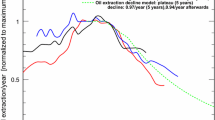Abstract
The US Department of Energy's Energy Information Administration (EIA) recently predicted that world oil production could continue to increase for more than three decades, based on the recent US Geological Survey (USGS) evaluation of world oil resources and a simple, transparent model. However, it can be shown that this model is not consistent with actual oil production records in many different regions, particularly that of the US, from which it was derived. A more careful application of the EIA model, using the same resource estimates, indicates that at best non-OPEC oil production can increase for less than two decades, and should begin to decline at the latest sometime between 2015 and 2020. OPEC at this point will completely control the world oil market and will need to meet increased demand as well as compensate for declining production of non-OPEC producers. OPEC could control the market even sooner than this, given its larger share of proven oil reserves, probable difficulties in transforming non-OPEC undiscovered reserves into proven reserves, and the converging interests of all oil producers as reserves are depleted. This has significant implications for the world economy and for US national security.
Similar content being viewed by others
REFERENCES
Ahlbrandt, T., 2000, USGS (US Geological Survey), world energy resources, world petroleum assessment 2000. Available at www.usgs.gov.
Betancourt, R., 1978, Venezuela's oil (translated by Donald Peck): George Allen and Unwin, London, 248 p.
Campbell, C., and Laherrere, J., 1998, The end of cheap oil, Sci. Am. v. 278, no. 3, p. 78-83.
Cavallo, A., 1996, Security of supply: a neglected fossil fuel subsidy: Wind Engineer., v. 20, no. 2, p. 47-53.
Duncan, R. C., and Youngquist, W., 1999, Encircling the peak of world oil production: Nat. Resources Res., v. 8, no. 3, p. 219-225.
Hakes, J., 2000, Long term world oil supply,US DOE EIA (Energy Information administration), presentation to the American Association of Petroleum Geologists, (New Orleans, LA), Available at www.eia.doe.gov/pub/oil gas/.
Hubbert, M. K., 1962, Energy resources, a report to the committee on natural resources of the NAS-NRC, Publication 1000-D NAS-NRC, 141 p.
Johansson, T. B., Kelly, T., Reddy, A., and Williams, R., eds., Burnam, L., exec. ed., 1993, renewable energy: sources for fuels and electricity, Island Press, Washington, DC, 1160 p.
US DOE EIA, 1996, Annual energy outlook 1997, DOE/EIA 0383 (97), p. 28. Dec.
USDOEEIA, 2000, International energy outlook 2000, DOE/EIA 0484, p. 28-29. March 2000.
Von Weizsacker, E., Lovins, A., and Lovins, H., 1997, Factor four: doubling wealth, halving resource use: Earthscan Publishers, UK, 397 p.
Weaver, J. L., 1986, Unitization of oil and gas fields in Texas: A study of legislative, administrative, and judicial policies: Resources for the Future, Johns Hopkins Univ. Press (Washington, DC), 555 p.
Yergin, D., 1991, The prize: the epic quest for oil, money and power: Simon and Schuster, New York, p. 244-259.
Author information
Authors and Affiliations
Rights and permissions
About this article
Cite this article
Cavallo, A.J. Predicting the Peak in World Oil Production. Natural Resources Research 11, 187–195 (2002). https://doi.org/10.1023/A:1019856621335
Issue Date:
DOI: https://doi.org/10.1023/A:1019856621335




